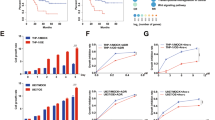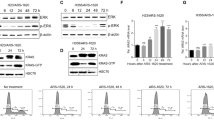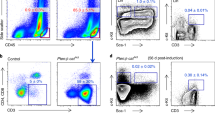Abstract
The development of resistance against chemotherapy remains one of the major challenges in the clinical management of leukemia. There is still limited insight into the molecular mechanisms that maintain the chemotherapy-resistant phenotype, despite the obvious clinical relevance that such knowledge would have. In this study, we show that the chemotherapy-resistant phenotype of myeloid leukemia cells correlates with activation of the Hedgehog (Hh) pathway, whereas in chemosensitive cells, such activation is less pronounced. Importantly, the overexpression of Hh pathway components induces chemoprotection and inhibition of the pathway reverts chemoresistance of Lucena-1 cells, apparently by interfering with P-glycoprotein-dependent drug resistance. Our data thus identify the Hh pathway as an essential component of multidrug resistance (MDR) myeloid leukemia and suggest that targeting the Hh pathway might be an interesting therapeutic avenue for overcoming MDR resistance in myeloid leukemia.
This is a preview of subscription content, access via your institution
Access options
Subscribe to this journal
Receive 50 print issues and online access
$259.00 per year
only $5.18 per issue
Buy this article
- Purchase on Springer Link
- Instant access to full article PDF
Prices may be subject to local taxes which are calculated during checkout






Similar content being viewed by others
References
Bijlsma MF, Spek CA, Zivkovic D, van de Water S, Rezaee F, Peppelenbosch MP . (2006). Repression of smoothened by patched-dependent (pro-)vitamin D3 secretion. PLoS Biol 4: e232.
Chen JK, Taipale J, Cooper MK, Beachy PA . (2002). Inhibition of Hedgehog signaling by direct binding of cyclopamine to Smoothened. Genes Dev 16: 2743–2748.
Dean M . (1997). Towards a unified model of tumor suppression: lessons learned from the human patched gene. Biochim Biophys Acta 1332: 43–52.
Dean M, Fojo T, Bates S . (2005). Tumour stem cells and drug resistance. Nat Rev Cancer 5: 275–284.
Diehl KM, Keller ET, Ignatoski KM . (2007). Why should we still care about oncogenes? Mol Cancer Ther 6: 418–427.
Dierks C, Beigi R, Guo GR, Zirlik K, Stegert MR, Manley P et al. (2008). Expansion of Bcr-Abl-positive leukemic stem cells is dependent on Hedgehog pathway activation. Cancer Cell 14: 238–249.
Hartree EF . (1972). Determination of proteins: a modification of Lowry method that give a linear photometric response. Anal Biochem 48: 422–427.
Higgins CF . (2007). Multiple molecular mechanisms for multidrug resistance transporters. Nature 446: 749–757.
Hofmann I, Stover EH, Cullen DE, Mao J, Morgan KJ, Lee BH et al. (2009). Hedgehog signaling is dispensable for adult murine hematopoietic stem cell function and hematopoiesis. Cell Stem Cell 4: 559–567.
Kobune M, Takimoto R, Murase K, Iyama S, Sato T, Kikuchi S et al. (2009). Drug resistance is dramatically restored by hedgehog inhibitors in CD34+ leukemic cells. Cancer Sci 100: 948–955.
Kroemer G, Pouyssegur J . (2008). Tumor cell metabolism: cancer's achilles’ heel. Cancer Cell 13: 472–482.
Lauth M, Bergström A, Shimokawa T, Toftgård R . (2007). Inhibition of GLI-mediated transcription and tumor cell growth by small-molecule antagonists. Proc Natl Acad Sci USA 104: 8455–8460.
Lauth M, Toftgård R . (2007). The Hedgehog pathway as a drug target in cancer therapy. Curr Opin Investig Drugs 8: 457–461.
Löwenberg B . (2007). On the road to new drugs in acute myeloid leukemia. JCO 25: 1–2.
Martelli AM, Tazzari PL, Tabellini G, Bortul R, Billi AM, Manzoli L et al. (2003). A new selective AKT pharmacological inhibitor reduces resistance to chemotherapeutic drugs, TRAIL, all-trans-retinoic acid, and ionizing radiation of human leukemia cells. Leukemia 17: 1794–1805.
Mosmann T . (1983). Rapid colorimetric assay for cellular growth and survival: application to proliferation and cytotoxicity assay. J Immunol Meth 65: 55–63.
O'Hare T, Corbin AS, Druker BJ . (2006). Targeted CML therapy: controlling drug resistance, seeking cure. Curr Opin Genet Dev 16: 92–99.
Rumjanek VM, Trindade GS, Wagner-Souza K, de-Oliveira MC, Marques-Santos LF, Maia RC et al. (2001). Multidrug resistance in tumor cells: characterisation of the multidrug resistant cell line K562-Lucena 1. Ann Acad Bras Ci 73: 57–69.
Sims-Mourtada J, Izzo JG, Apisarnthanarax S, Wu TT, Malhotra U, Luthra R et al. (2006). Hedgehog: an attribute to tumor regrowth after chemoradiotherapy and a target to improve radiation response. Clin Cancer Res 12: 6565–6572.
Svärd J, Heby-Henricson K, Persson-Lek M, Rozell B, Lauth M, Bergström A et al. (2006). Genetic elimination of suppressor of fused reveals an essential repressor function in the mammalian Hedgehog signaling pathway. Dev Cell 10: 187–197.
Zhao C, Chen A, Jamieson CH, Fereshteh M, Abrahamsson A, Blum J et al. (2009). Hedgehog signalling is essential for maintenance of cancer stem cells in myeloid leukaemia. Nature 458: 776–779.
Zhao Y, Tong C, Jiang J . (2007). Hedgehog regulates smoothened activity by inducing a conformational switch. Nature 450: 252–258.
Acknowledgements
KCS Queiroz is supported by the Maag-, Lever-, Darmstichting. CV Ferreira is supported by a research fellowship from CNPq. MP Peppelenbosch and CA Spek acknowledge the support of the Top-Institute pharma. We are grateful to Professor Vivian Rumjanek (Federal University of Rio de Janeiro) for donating Lucena-1 cells.
Author information
Authors and Affiliations
Corresponding author
Ethics declarations
Competing interests
The authors declare no conflict of interest.
Rights and permissions
About this article
Cite this article
Queiroz, K., Ruela-de-Sousa, R., Fuhler, G. et al. Hedgehog signaling maintains chemoresistance in myeloid leukemic cells. Oncogene 29, 6314–6322 (2010). https://doi.org/10.1038/onc.2010.375
Received:
Revised:
Accepted:
Published:
Issue Date:
DOI: https://doi.org/10.1038/onc.2010.375
Keywords
This article is cited by
-
Post-transplant maintenance therapy in acute myeloid leukemia after allogeneic hematopoietic stem cell transplantation harmonizing multiple therapeutic modalities including targeted therapy, immunotherapy and cellular therapy
International Journal of Hematology (2023)
-
Novel CAR T therapy is a ray of hope in the treatment of seriously ill AML patients
Stem Cell Research & Therapy (2021)
-
Inhibition of EZH2 by chidamide exerts antileukemia activity and increases chemosensitivity through Smo/Gli-1 pathway in acute myeloid leukemia
Journal of Translational Medicine (2021)
-
GLI1 reduces drug sensitivity by regulating cell cycle through PI3K/AKT/GSK3/CDK pathway in acute myeloid leukemia
Cell Death & Disease (2021)
-
Compassionate use of glasdegib in combination with low-dose cytarabine for relapsed, refractory acute myeloid leukemia or high-risk myelodysplastic syndrome
Annals of Hematology (2021)



